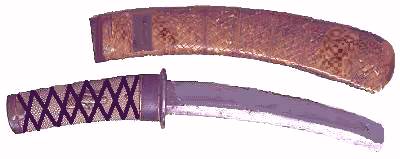 UNUSUAL STYLES OF TANTO
UNUSUAL STYLES OF TANTO 
 UNUSUAL STYLES OF TANTO
UNUSUAL STYLES OF TANTO 

The kubikiri (kubigiri) is an unusual form for a Japanese tanto. On a kubikiri, the cutting edge is on the inside curvature (extreme uchi-sori); most are of the kiri-ha shape and have no kissaki (point). There were several possible uses and many "tall tales" about kubikiri. The term "kubikiri" is traditionally translated as "head cutter". This style of tanto may have been carried by attendants to high ranking samurai whose job was to remove the heads of dead enemies as "trophies of battle". While this usage was possibly real in ancient times, in later eras it would have been largely a ceremonial sword used possibly as a badge of rank. These are also referred to as bokuwari tanto which means wood splitter. They may have been used to cut charcoal for sumi or incense for either the tea ceremony or incense game. Some people also call this style of tanto a "doctor's knife". As there is no point (kissaki), it supposedly could not be used offensively and was therefore carried by those persons of stature who were entitled to wear a sword, but who were "non-combatants". It is also possible that this style of tanto (hanakiri) was made for wealthy individuals as tools for trimming bonsai and doing garden work or ikebana, similar to the saw tanto below. Another possibility is that they were used by forestry officials for taking trimmings or cuttings for propagation. Tanto of this type date from the Meiji to early Showa eras, a period when most sword makers and koshirae artists had little work making traditional swords. Whatever the usage, this style of tanto is relatively rare in Western collections.
Tanto in koshirae simulating a folded Japanese fan are not particularly uncommon. Most have rather low grade blades, although some good quality blades are found mounted in this manner. Legend has it that this style of mounting was used by women and retired samurai as well as doctors, monks and others who did not wish to appear to be carrying a weapon. Fan style mounts were also widely produced in the late 19th and early 20th Centuries as tourist items. The majority of these have poor quality blades.

Also, most carved bone, dragon and fish tanto that are found have poor quality blades and are considered "tourist tanto" which are of no interest to Nihonto collectors.

Ken are one of the rarer styles of tanto. Ken have double edged blades and were mainly made as Buddhist ritual implements although it is not uncommon to find them mounted and used as tanto. Some ken style tanto were made from cut down yari. Ken style tanto were made in Koto, Shinshinto and Gendai eras; but few were made during the Shinto period (few tanto of any style were made during the Shinto era). Ken blades may have parallel edges or double concave shapes as above. Some of the top sword smiths in history made ken as offerings to various temples. It is not uncommon to find ken with a vajra (double thunderbolt) style hilt in keeping with their use as Buddhist ritual implements.

Yari (Japanese lance heads) are occasionally found mounted as tanto. The tang (nakago) is drastically shortened to fit into a tanto size tsuka (handle). This means that if the yari was originally signed by the swordsmith, that the signature (mei) is most likely lost. Small yari tanto were sometimes carried as dirks (kwaiken) by women or as armor piercing tanto by samurai. Yari tanto will normally have a triangular cross-section as distinct from ken tanto which have a diamond cross-section. Also yari tanto will have a reduced "shoulder area" where the blade enters the tsuka and normally have no habaki (blade collar). Yari tanto vary in quality. Some were made by swordsmiths and will have hada and hamon, others were mass produced for foot soldiers and have no hamon. The hi (groove) on the flat side of the yari will possibly be colored with red lacquer.

Single shot pistols in tanto koshirae are relatively rare. The matchlock gun was introduced into Japan in the 15th Century by the Portuguese. The Japanese readily adopted the gun as a weapon of both military combat and personal defense although it was considered not to be a weapon worthy of the samurai. Pistol tanto were carried as weapons of personal defense. Most pistol tanto date from the late 18th and 19th Centuries. They are single shot pistols with fold down triggers and were not very accurate. Some scholars consider them a fad item for the wealthy of the period.

Hachiwara are not actually tanto as they are not a sword, but rather a forged iron bar designed as a defensive weapon against swords. They are sometimes called sword breakers or helmet breakers. The blades are normally of square cross-section with a hook next to the grip, approximately 12 to 15 inches in length. The mounts are commonly of carved wood or carved cinnabar lacquer. Some hachiwara were made by noted swordsmiths and may be signed.

This item is most unusual - a saw blade mounted in handachi style koshirae. The forged blade is 9.75 inches long and the brass mounts appear to be original to the blade. The purpose of this item is unknown. Is is speculated that is a fire fighter's tanto from the late Edo period; but it could be a pruning saw for bonsai? a carpenter's or cabinet maker's saw? an arborist's saw for pruning trees? It is unusual to find tools in sword koshirae whatever its usage.

|
Gendai | Jumei Tosho | Origami | Flaws | Polearms | Tsuba | Logos | Real? | Clubs | Books | Events | Listservs | Kanji | Sageo Nakirishi Mei | Measure | NBTHK | FAQ | Sinclaire | Articles | Sword Sites | Japan Sites | Martial Arts | World Swords Yoshichika | Kanefusa | Kanezane | Teruhide | Koa Isshin | Nagamitsu | Emura | Tanto | Yoshimichi | Yasunori | Shigetsugu |